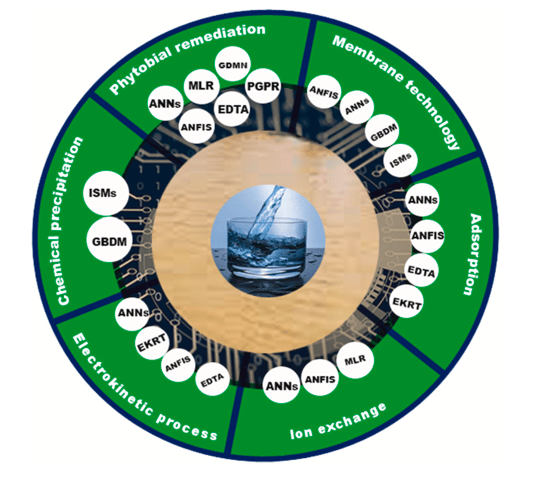The Role of AI and Advanced Technologies in Water Pollution Control: Addressing the Crisis in Ghana’s Pra River Basin
AI and advanced water treatment technologies offer sustainable solutions to combat severe pollution in Ghana’s Pra River Basin, caused largely by illegal mining.
AI
Harriet Comley
3/6/20254 分钟阅读


Nti, E., et al. (2024). Water pollution control and revitalization using advanced technologies: Uncovering artificial intelligence options towards environmental health protection, sustainability, and water security. PMC PubMed Central. 11(9), pp.1-13.
Water pollution remains a significant challenge worldwide, particularly in regions where industrial and illegal activities compromise water quality. One such example is Ghana’s Pra River Basin, a critical water source supporting 41 districts and 1,300 towns. The basin, covering 23,321 km², has suffered extensive pollution due to illegal mining (locally known as galamsey), chemical dumping, and livestock waste. Addressing this crisis requires a strategic blend of advanced water purification technologies and artificial intelligence (AI) to ensure environmental health protection, sustainability, and water security.
The Problem: Pollution in the Pra River Basin
Ghana’s water pollution crisis stems from several sources, including oil spills, waste dumping, illegal fishing, and mining. Illegal mining is the leading contributor, accounting for 60% of critically polluted water bodies in the country. The mining process releases hazardous heavy metals, including lead (Pb), cadmium (Cd), chromium (Cr), nickel (Ni), iron (Fe), and zinc (Zn), contaminating the river. These metal concentrations exceed the World Health Organization’s (WHO) safe water guidelines, rendering the water unsafe for domestic use. The problem is compounded by high turbidity levels, particularly in downstream communities, leading to increased arsenic contamination.
Moreover, illegal mining operations commonly use mercury to extract ores due to its cost-effectiveness and efficiency. However, residual mercury from these activities infiltrates the soil, surface water, and aquatic ecosystems, exacerbating the contamination problem. The consequences of mercury pollution include severe ecological damage, bioaccumulation in the food chain, and long-term health risks for local communities, such as neurological disorders and kidney damage. Without intervention, the water crisis in the Pra River Basin threatens both public health and economic stability, given that agriculture, fishing, and potable water supplies rely heavily on the river’s resources.
The Need for an Advanced Water Security System
Effective pollution control requires a holistic water security policy that not only addresses contamination but also provides sustainable solutions for long-term water management. Various advanced water purification technologies have been identified to mitigate pollution in the Pra River Basin, including:
1. Water Pollution Control Technologies
Physical separation: Filtration methods to remove solid contaminants.
Chemical breakdown mechanisms: Processes such as chemical precipitation to neutralize harmful substances.
Biological degradation: Utilizing microorganisms to break down pollutants.
Key Technological Solutions for Water Purification
Several advanced technologies have been identified for effective water treatment:
Adsorption – Considered the safest method for removing mercury contamination. Adsorbent materials like activated carbon and biochar are widely used to capture heavy metals.
Ion Exchange – Replaces unwanted ions in water with desirable ions, particularly effective in removing toxic metals like lead and mercury.
Electrokinetic Processes – Environmentally friendly remediation method that uses electric currents to remove contaminants from water and soil.
Chemical Precipitation – A method that involves the conversion of dissolved metals into solid particles that can be filtered out, reducing toxicity levels.
Phytobial Remediation – Uses microorganisms to enhance phytoremediation in removing contaminants, particularly heavy metals, from polluted water and soil.
Membrane Technology – Effectively separates pollutants from water sources using ultrafiltration and nanofiltration techniques.
Additionally, nanotechnology has emerged as a promising cost-effective solution for water treatment, enhancing the efficiency of adsorption, membrane filtration, and bioremediation techniques. The ability of nanomaterials to selectively remove toxic metals while minimizing energy consumption makes them an attractive alternative to conventional methods.
The Role of AI in Water Pollution Management
AI is revolutionizing water pollution control by optimizing treatment processes, improving efficiency, and reducing costs. The application of AI in key water purification methods includes:
Adsorption: AI models, including artificial neural networks (ANNs) and adaptive neuro-fuzzy inference systems (ANFIS), can optimize parameters such as temperature, pH levels, and adsorbent surface area for maximum effectiveness.
Ion Exchange: AI can enhance ion exchange processes by monitoring ionic concentrations and automating the removal of toxic metals such as lead and mercury. AI-powered sensors can provide real-time data on water quality, ensuring precise and efficient treatment.
Electrokinetic Processes: AI enhances efficiency by analyzing environmental data and optimizing remediation conditions. Machine learning models can predict contamination levels and adjust electrokinetic treatments accordingly.
Chemical Precipitation: AI-driven techniques predict contamination levels and improve future precipitation estimates for targeted treatment. AI can also analyze the effectiveness of coagulants in real time, ensuring better removal of contaminants.
Phytobial Remediation: AI monitors plant growth, contaminant levels, and bioavailability, making remediation more effective. AI-based remote sensing technologies can track pollutant absorption rates in real-time, allowing for data-driven decision-making in phytoremediation efforts.
Membrane Technology: AI helps resolve complex membrane filtration challenges, improving the separation of pollutants from clean water. Advanced AI models can detect fouling in membranes, predict maintenance schedules, and enhance overall filtration efficiency.
Figure 1. Water pollution control technologies, materials and AI examples. [Source: Nti et al., 2024]
Combining Technologies for Maximum Effectiveness
There is currently no single technology capable of addressing all pollution challenges in the Pra River Basin. A combination of these advanced methods is required to ensure a comprehensive and effective water treatment strategy. Business models integrating multiple technologies provide more efficient solutions, particularly for regions heavily affected by illegal mining and industrial pollution.
Practitioners are increasingly adopting hybrid solutions that merge adsorption, membrane filtration, and electrokinetic processes to maximize pollution removal. Additionally, the integration of AI-driven predictive analytics ensures that interventions are data-driven, reducing waste and enhancing sustainability. Public-private partnerships, alongside government policies promoting responsible mining practices, will be crucial in implementing these solutions at scale.
Conclusion
Water pollution in the Pra River Basin presents a serious environmental and public health threat. However, advanced technologies, coupled with AI-driven optimization, offer effective solutions for mitigating contamination and ensuring sustainable water security. By integrating adsorption, ion exchange, electrokinetic processes, chemical precipitation, phytobial remediation, and membrane technology, stakeholders can work towards restoring the health of Ghana’s water bodies. The adoption of AI further enhances efficiency and predictive capabilities, making water purification efforts more effective in the long term.
As businesses, policymakers, and environmental advocates push for cleaner water systems, the future of water security depends on embracing technological innovation to tackle pollution challenges head-on. Only through a multi-faceted approach that combines cutting-edge technologies with AI-driven solutions can the pressing issue of water pollution in Ghana be effectively addressed.


